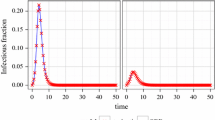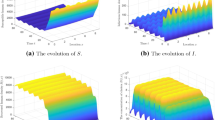Abstract
Multiple transmission pathways exist for many waterborne diseases, including cholera, Giardia, Cryptosporidium, and Campylobacter. Theoretical work exploring the effects of multiple transmission pathways on disease dynamics is incomplete. Here, we consider a simple ODE model that extends the classical SIR framework by adding a compartment (W) that tracks pathogen concentration in the water. Infected individuals shed pathogen into the water compartment, and new infections arise both through exposure to contaminated water, as well as by the classical SIR person–person transmission pathway. We compute the basic reproductive number (ℛ0), epidemic growth rate, and final outbreak size for the resulting “SIWR” model, and examine how these fundamental quantities depend upon the transmission parameters for the different pathways. We prove that the endemic disease equilibrium for the SIWR model is globally stable. We identify the pathogen decay rate in the water compartment as a key parameter determining when the distinction between the different transmission routes in the SIWR model is important. When the decay rate is slow, using an SIR model rather than the SIWR model can lead to under-estimates of the basic reproductive number and over-estimates of the infectious period.
Similar content being viewed by others
References
Andersen, M.D., Neumann, N.F., 2007. Giardia intestinalis: new insights on an old pathogen. Rev. Med. Microbiol. 18(2), 35–42.
Anderson, R., Watson, R., 1980. On the spread of a disease with gamma distributed latent and infectious periods. Biometrika 67(1), 191–198.
Anderson, R.M., May, R.M., 1991. Infectious Diseases of Humans: Dynamics and Control. Oxford University Press, Oxford.
Ashbolt, N., 2004. Microbial contamination of drinking water and disease outcomes in developing regions. Toxicology 198, 229–238.
Auld, H., MacIver, D., Klaassen, J., 2004. Heavy rainfall and waterborne disease outbreaks: the Walkerton example. J. Toxicol. Environ. Health A 67, 1879–1887.
Barker, J., Vipond, I., Bloomfield, S., 2004. Effects of cleaning and disinfection in reducing the spread of norovirus contamination via environmental surfaces. J. Hosp. Infect. 58, 42–49.
Brookhart, M.A., Hubbard, A., van der Laan, M.J., Colford, J., Eisenberg, J.N.S., 2002. Statistical estimation of parameters in a disease transmission model: analysis of a Cryptosporidium outbreak. Stat. Med. 21(23), 3627–3638.
Butzler, J., 2004. Campylobacter, from obscurity to celebrity. Clin. Microbiol. Infect. 10(10), 868–876.
Codeco, C., 2001. Endemic and epidemic dynamics of cholera: the role of the aquatic reservoir. BMC Infect. Dis. 1.
Curriero, F., Patz, J., Rose, J., Lele, S., 2001. The association between extreme precipitation and waterborne disease outbreaks in the United States, 1948–1994. Am. J. Public Health 91, 1194–1199.
Cvjetanovic, B., Grab, B., Uemura, K., 1978. Dynamics of acute bacterial diseases, epidemiological models and their application to public health. Bull. World Health Organ. 56(S1), 1–143.
Duizer, E., Koopmans, M., 2006. Tracking foodborne viruses: lessons from noroviruses. In: Motarjemi, Y., Adam, M. (Eds.), Emerging Foodborne Pathogens, pp. 77–110. CRC Press, Boca Raton.
Eisenberg, J.N., Brookhart, M., Rice, G., Brown, M., Colford, J., 2002. Disease transmission models for public health decision making: analysis of epidemic and endemic conditions caused by waterborne pathogens. Environ. Health Perspect. 110(8), 783–790.
Eisenberg, J.N., Lewis, B.L., Porco, T.C., Hubbard, A.H., Colford, J.M. Jr., 2003. Bias due to secondary transmission in estimation of attributable risk from intervention trials. Epidemiology 14(4), 442–450.
Faruque, S., Albert, M., Mekalanos, J., 1998. Epidemiology, genetics, and ecology of toxigenic Vibrio cholerae. Microbiol. Mol. Biol. Rev. 62(4), 1301–1314.
Faruque, S., Islam, M., Ahmad, Q., Faruque, A.S.G., Sack, D., Nair, G., Mekalanos, J., 2005. Self-limiting nature of seasonal cholera epidemics: role of host-mediated amplification of phage. Proc. Natl. Acad. Sci. USA 102(17), 6119–6124.
Fenichel, N., 1971. Persistence and smoothness of invariant manifolds for flows. Indiana Univ. Math. J. 21(3), 193–226.
Flanagan, P., 1992. Giardia—diagnosis, clinical course and epidemiology. A review. Epidemiol. Infect. 109(1), 1–22.
Ford, T., 1999. Microbiological safety of drinking water: United States and global perspectives. Environ. Health Perspect. 107(Suppl. 1), 191–206.
Gerba, C., Rose, J., Haas, C., Crabtree, K., 1996. Waterborne rotavirus: a risk assessment. Water Res. 30, 2929–2940.
Goh, K., Teo, S., Lam, S., Ling, M., 1990. Person-to-person transmission of cholera in a psychiatric hospital. J. Infect. 20(3), 193–2000.
Guckenheimer, J., Holmes, P., 1983. Nonlinear Oscillations, Dynamical Systems, and Bifurcations of Vector Fields. Springer, Berlin.
Hartley, D., Morris, J., Smith, D., 2006. Hyperinfectivity: a critical element in the ability of V. cholerae to cause epidemics? PLoS Med. 3, 63–69.
Hirsch, M.W., Smale, S., 1974. Differential Equations, Dynamical Systems, and Linear Algebra. Academic Press, New York.
Hunter, P., Waite, M., Ronchi, E. (Eds.), 2003. Drinking Water and Infectious Disease: Establishing the Links. CRC Press, Boca Raton.
Hyman, J.M., Li, J., Ann Stanley, E., 1999. The differential infectivity and staged progression models for the transmission of HIV. Math. Biosci. 155, 77–109.
Jensen, M., Faruque, S., Mekalanos, J., Levin, B., 2006. Modeling the role of bacteriophage in the control of cholera outbreaks. Proc. Natl. Acad. Sci. USA 103(12), 4652–4657.
Jones, C.K., 1995. Geometric singular perturbation theory. In: Lecture Notes in Mathematics, vol. 1609, pp. 44–118. Springer, Berlin.
Jones, K., 2001. Campylobacters in water, sewage and the environment. J. Appl. Microbiol. 90(S6), 68S–79S.
Karanis, P., Kourenti, C., Smith, H., 2007. Waterborne transmission of protozoan parasites: a worldwide review of outbreaks and lessons learnt. J. Water Health 5(1), 1–38.
Kermack, W.O., McKendrick, A.G., 1927. A contribution to the mathematical theory of epidemics. Proc. R. Soc. Lond. A 115, 700–721.
King, A.A., Ionides, E.L., Pascual, M., Bouma, M.J., 2008. Inapparent infections and cholera dynamics. Nature 454, 877–880.
King, B., Monis, P., 2007. Critical processes affecting Cryptosporidium oocyst survival in the environment. Parasitology 134, 309–323.
Koelle, K., Pascual, M., Yunus, M., 2005. Pathogen adaptation to seasonal forcing and climate change. Proc. R. Soc. Lond. B 272, 971–977.
Koelle, K., Pascual, M., Yunus, M., 2006. Serotype cycles in cholera dynamics. Proc. R. Soc. Lond. B 273, 2879–2886.
Korobeinikov, A., 2004. Lyapunov functions and global properties for SEIR and SEIS epidemic models. Math. Med. Biol. 21, 75–83.
Korobeinikov, A., Wake, G., 2002. Lyapunov functions and global stability for SIR, SIRS, and SIS epidemiological models. Appl. Math. Lett. 15, 955–961.
LaSalle, J., Lefschetz, S., 1961. Stability by Liapunov’s Direct Method. Academic Press, New York.
Leclerc, H., Schwartzbrod, L., Dei-Cas, E., 2002. Microbial agents associated with waterborne diseases. Crit. Rev. Microbiol. 28(4), 371–409.
Ma, J., Earn, D., 2006. Generality of the final size formula for an epidemic of a newly invading infectious disease. Bull. Math. Biol. 68, 679–702.
Marshall, M., Naumovitz, D., Ortega, Y., Sterling, C., 1997. Waterborne protozoan pathogens. Clin. Microbiol. Rev. 10(1), 67–85.
Mckay, M., Beckman, R., Conover, W., 1979. Comparison of 3 methods for selecting values of input variables in the analysis of output from a computer code. Technometrics 21(2), 239–245.
Nasser, A., 1994. Prevalence and fate of hepatitis A virus in water. Crit. Rev. Environ. Sci. Technol. 24(4), 281–323.
Nelder, J., Mead, R., 1965. A simplex method for function minimization. Comput. J. 7, 308–313.
Pascual, M., Rodo, X., Ellner, S.P., Colwell, R., Bouma, M.J., 2000. Cholera dynamics and El Niño-Southern oscillation. Science 289, 1766–1769.
Press, W.H., Teukolsky, S.A., Vetterling, W.T., Flannery, B.P., 1992. Numeric Recipes in C: The Art of Scientific Computing, 2nd edn. Cambridge University Press, New York.
Prüss-Üstün, A., Bos, R., Gore, F., Bartram, J., 2008. Safer Water, Better Health: Costs, Benefits and Sustainability of Interventions to Protect and Promote Health. World Health Organization, Geneva.
Robertson, L., Campbell, A., Smith, H., 1992. Survival of Cryptosporidium oocysts under various environmental pressures. Appl. Environ. Microbiol. 58, 3494–3500.
Rollins, D., Colwell, R., 1986. Viable but nonculturable stage of Campylobacter jejuni and its role in survival in the natural aquatic environment. Appl. Environ. Microbiol. 52, 531–538.
Rose, J., 1997. Environmental ecology of Cryptosporidium and public health implications. Annu. Rev. Public Health 18, 135–161.
Sack, D., Sack, R., Nair, G., Siddique, A., 2004. Cholera. Lancet 363, 223–233.
Saltelli, A., Chan, K., Scott, E., 2000. Sensitivity Analysis. Wiley, New York.
Schuster, C., Ellis, A., Robertson, W., Charron, D., 2005. Infectious disease outbreaks related to drinking water in Canada, 1974–2001. Can. J. Public Health 96(4), 254–258.
Segel, L., 1988. On the validity of the steady state assumption of enzyme kinetics. Bull. Math. Biol. 50, 579–593.
Snow, J., 1936. Snow on Cholera: Being a Reprint of Two Papers. The Commonwealth Fund, New York.
Tamplin, M., Gauzens, A., Huq, A., Sack, D., Colwell, R., 1990. Attachment of Vibrio cholerae serogroup-O1 to zooplankton and phytoplankton of Bangladesh waters. Appl. Environ. Microbiol. 56(6), 1977–1980.
Thomas, C., Hill, D., Mabey, M., 1999. Evaluation of the effect of temperature and nutrients on the survival of Campylobacter spp. in water microcosms. J. Appl. Microbiol. 86(6), 1024–1032.
van den Driessche, P., Watmough, J., 2002. Reproduction numbers and sub-threshold endemic equilibria for compartmental models of disease transmission. Math. Biosci. 180, 29–48.
Wagner, B.G., Earn, D., 2010. Population dynamics of live-attenuated virus vaccines. Theor. Popul. Biol., in press.
Wallinga, J., Lipsitch, M., 2007. How generation intervals shape the relationship between growth rates and reproductive numbers. Proc. R. Soc. B 274, 599–604.
WHO, 2009. Cholera: global surveillance summary, 2008. Wkly. Epidemiol. Rec. 84, 309–324.
Wu, R., 1999. Eutrophication, water borne pathogens and xenobiotic compounds: environmental risks and challenges. Mar. Pollut. Bull. 39, 11–22.
Xu, H., Roberts, N., Singleton, F., Attwell, R., Grimes, D., Colwell, R., 1982. Survival and viability of nonculturable Escherichia coli and Vibrio cholerae in the estuarine and marine environment. Microb. Ecol. 8, 313–323.
Author information
Authors and Affiliations
Corresponding author
Rights and permissions
About this article
Cite this article
Tien, J.H., Earn, D.J.D. Multiple Transmission Pathways and Disease Dynamics in a Waterborne Pathogen Model. Bull. Math. Biol. 72, 1506–1533 (2010). https://doi.org/10.1007/s11538-010-9507-6
Received:
Accepted:
Published:
Issue Date:
DOI: https://doi.org/10.1007/s11538-010-9507-6




